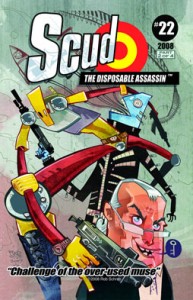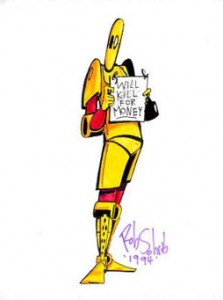By John Mayfield/reporter

Comic fans rejoice!
Once again “It’s cool to be a robot.”
One of the most underground, sought-after and bizarre action-packed comics from the ’90s has risen from the grave.
SCUD: The Disposable Assassin has reappeared on the comic shelves.
A five-man comic company called Fire Man Press published Scud from 1994 to 1998.
In the four years it was an ongoing title, only 20 issues were published.
The standard yearly output of an ongoing series is 12 issues.
Almost any other title with such an abysmal release record would have been forgotten by the fans after just a year, but there was something different about Scud.
Scud is the brainchild of Rob Schrab; together with co-writer Dan Harmon, the two managed to create something unique.
At that time in the ’90s, the comic world was bogged down by over editing, market saturation and an inability to break away from decade-old story lines.

Scud brought something new and different to the comic shops. Its art was vibrant in black and white, its layout flowed more like an action movie storyboard than a traditional comic and its premise was comically absurd.
Schrab envisioned a world full of robots, mutants, occult monsters, dinosaurs, zombies, movie stars, androids and historical figures where life is worth a handful of coins, on which was printed the head of President Frankenstein.
The story revolves around Scud, an assassin robot from the Scudco heart-breaker series.
These robots can be purchased from sidewalk vending machines.
Once the robot has been purchased, it is given a target. Upon killing the target, it self-destructs.
The main character of the series is one such robot; however, he realizes that by killing his target, he will be killing himself, so he opts to dismember the target and put it on life support.
Scud’s target was a clear representation of the “anything goes” mentality of the first half of the series.
The target would spew obscure pop culture references from the mouth-knees of its arm-legs.
It was a cobbled together monster with a giant squid strapped to its torso, mousetrap hands and an electrical plug for a head.
It went by the name of Jeff.
Schrab’s comic was known for its inability to be pigeonholed.
The characters were beyond diverse, and while there was always a strong comical overtone, the series ran the breadth of standard genres.
Near the end of the series’ first run, it even morphed into a love story of sorts.
And it became painfully obvious that the passion that Schrab and Harmon started out with had faded.
The credits page of Scud had always read like movie credits, with suggested voice actors for the characters.
By ’98 they went so far as to assign a sound track for each issue with page listings for the appropriate songs.
At that time, the two had recently moved to Los Angeles, and it was clear that their interests had shifted to Hollywood.
They began working on scripts and thus began the decade-long cliffhanger for Scud.
During the 10-year hiatus, Schrab and Harmon made names for themselves in Hollywood by selling a script for the movie Monster House in the beginning of ’99.
They would later create the online site and monthly film festival, Channel101, which has since become a breeding ground for new comedic talent such as Tim Hiedecker and Eric Warhiem.
Currently, Schrab is writing and directing The Sarah Silverman Program for Comedy Central.
Schrab and Harmon have recently finished the final four issues of Scud with the last issue set for a late May release.
The entire series will be released in one book this June.
The style of Scud has changed from 10 years ago.
In place of the movie-style credits and the storyboard flow are heavily refined art and punk design layout.
Scud’s back, if only for a short time.























